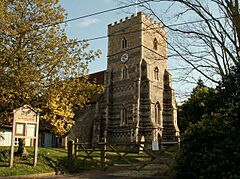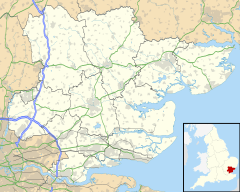Purleigh facts for kids
Quick facts for kids Purleigh |
|
|---|---|
 All Saints' Church, Purleigh |
|
| Population | 1,271 (2011) |
| OS grid reference | TL838020 |
| District |
|
| Shire county | |
| Region | |
| Country | England |
| Sovereign state | United Kingdom |
| Post town | Chelmsford |
| Postcode district | CM3 |
| Dialling code | 01245 & 01621 |
| Police | Essex |
| Fire | Essex |
| Ambulance | East of England |
| EU Parliament | East of England |
| UK Parliament |
|
Purleigh is a village in Essex, England. It is located on the Dengie peninsula, about 4 miles (6.4 km) south of Maldon. The village is part of the Maldon district.
The name 'Purleigh' was first recorded in 998 as Purlea. In the Domesday Book of 1086, it was called Purlai. The name means 'bittern clearing', referring to a type of bird.
Contents
How Purleigh is Governed
Purleigh has its own electoral ward. An electoral ward is an area that elects local representatives. This ward extends south to North Fambridge. In 2011, the total population of this ward was 3,419 people.
History of Purleigh Manor
A manor is a large estate or area of land. The manor of Purleigh has been owned by different families over many centuries.
Early Owners of Purleigh Manor
In 1086, during the Domesday Book survey, Eustace II, Count of Boulogne owned the manor of Purleigh. Later, in the late 1400s, Hugh Denys acquired the manor. He was an important person who worked for King Henry VII. When Hugh Denys died without children, he left the manor to his younger relative, John Denys. The Denys family, later known as Dennis, owned the manor until the early 1700s.
The Bonnell Family and Purleigh
In 1742, James Bonnell bought the manor of Purleigh. His father, Captain John Bonnell, was a merchant. James's sister, Sarah Bonnell, was very generous. When she died in 1768, she left money to start a charity school for girls in West Ham. This school, the Sarah Bonnell School, is still open today and is one of England's oldest girls' schools.
The Bonnell family owned Purleigh for many years. They also owned a place called Pelling Place in Old Windsor, Berkshire. In 1853, Mary Anne Harvey Bonnell, who was the lady of the manor, passed the estate to James Bonnell. This James Bonnell was a chemist and soda water maker from Carlisle.
The Irving Family Takes Over
The manor of Purleigh later passed to the Irving family. This happened in 1871 when Elizabeth Bonnell married William John Irving. William was a lawyer from Penrith, Cumbria. Sadly, in 1884, William and his three children drowned in a tragic accident.
The Purleigh Colony
In 1896, a special community called the Purleigh Colony was started at Cock Clarks. This was a Tolstoyan anarchist colony. People in the colony followed the ideas of Leo Tolstoy, a famous Russian writer. They believed in simple living and peaceful ways.
The colony started on a 10-acre plot of land. As more people joined, they rented nearby cottages. The colonists had a printing press. They printed translations of Tolstoy's works and a magazine called The New Order. For a while, the colony also gave shelter to some Doukhobors. These were people from Russia who had to leave their home because they were being treated unfairly.
The Purleigh Colony eventually broke up around 1900. Some members moved to Canada with the Doukhobors. Others went on to form a new community called the Whiteway Colony in Gloucestershire. Another group, led by Tolstoy's friend Vladimir Chertkov, moved to Tuckton in Dorset. There, they continued to print Tolstoy's books.
Things to Do in Purleigh
Purleigh has three local pubs: The Bell, The Fox and Hounds, and The Roundbush. The Bell is a very old building, dating back to the 14th century. It was updated in the 16th century.
The local school for children is Purleigh Community Primary School.
Purleigh playing field is home to the Purleigh Cricket Club. In 2008, the club set a British record. They scored 499 runs for 5 wickets in just 45 overs against Herongate II. This was an amazing achievement!
All Saints' Church
The main church in Purleigh is called All Saints' Church. It was built in the 14th century.
Lawrence Washington was a priest, or rector, in Purleigh from 1632 to 1643. He was the great-great-grandfather of George Washington, who became the first U.S. president. Lawrence Washington had to leave Purleigh because of disagreements, likely due to his support for the Royalists during a time of conflict. He died in 1652 and was buried in the churchyard of All Saints' Church in Maldon.
Rev Robert Francis Walker, a well-known translator of Christian books, was a curate at the church from 1819 to 1854. He is buried in the churchyard.
Images for kids
See also
 In Spanish: Purleigh para niños
In Spanish: Purleigh para niños




